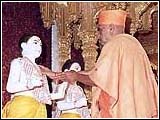| |
CE |
Day |
Event |
Vikram
Samvat |
Month |
Tithi |
| |
|
||
27 August || |
|
|
|
| 1821 |
Monday |
Vachanamrut Gadhada
II-13
This is one of the most important Vachanamruts for understanding
that Shriji Maharaj was himself supreme God. Shriji Maharaj reveals
his own greatness in a most humble and matter-of-fact way. He states
that he is the supreme God who is seated in the divine abode of
Akshardham. Then, Maharaj says, “Whoever meditates on the
human form of that God sees the luminous, divine form seated in
Akshardham. Such a person who meditates in this manner, traverses
maya and attains the highest state of enlightenment. So, even though
God assumes a human body, He is still divine, and the place where
He resides is also nirgun. His clothes, jewellery, vehicles, attendants,
food, drinks, etc. – in fact, any other objects which become
associated with Him – are all nirgun. One who realises God’s
form in this manner does not harbour any affection for the panchvishays,
just like I do not. He becomes independent.” |
1877 |
Shrãvan |
vad 30 |
| |
|
|
|
|
|
| |
|
|
|
|
|
| |
|
||
28 August || |
|
|
|
| 1820 |
Monday |
Vachanamrut Sarangpur-1
Shriji Maharaj describes the characteristics of a person who has
controlled his mind, “When the indriyas withdraw from the
panchvishays, i.e., sights, sounds, smells, tastes and touch, and
no desire to indulge in those vishays remains, then all of the indriyas
are said to be conquered. Moreover, when the indriyas do not come
into contact with the vishays, the mind also does not come into
contact with the indriyas, and its vrutti remains within the heart.
In this way, one who has shunned the panchvishays with absolute
resolution should be known as having conquered one’s mind.
But if one does have some affection for the vishays, then even if
one has conquered one’s mind, it should not be known as having
been conquered.”
|
1876 |
Shrãvan |
vad 5 |
| 1821 |
Tuesday |
Vachanamrut Gadhada
II-14
Having described his own true supreme form the previous day in Vachanamrut
Gadhada II-13, Shriji Maharaj describes the understanding of a devotee
who has attain oneness with God, “Once a person has known
that this is a neem tree, he never harbours the doubt in his mind,
‘Is this a neem tree, or not?’ Similarly, if one has
total realisation of God’s form as I described yesterday,
and if one no longer harbours any doubts about it, and if one’s
mind in no way causes one’s conviction of God to waver regardless
of the type of company one may encounter or the type of scriptures
one may hear, then such absolute conviction is what I call oneness.” |
1877 |
Bhãdarvo |
sud 1 |
| 1822 |
Wednesday |
Vachanamrut Gadhada
II-26
Shriji Maharaj warns of the fate of those who indulge in looking
at the drawbacks of others, “No matter how great he may be,
if a person perceives flaws in others and virtues in himself, he
will certainly encounter hindrances on the path of liberation.” |
1878 |
Bhãdarvo |
sud 11 |
1988
|
Friday |
 Murti-pratishtha
at Jackson, MS Murti-pratishtha
at Jackson, MS |
2054 |
Bhãdarvo |
sud 6 |
| 1977 |
Sunday |
 Murti-pratishtha
at New York Murti-pratishtha
at New York |
2033 |
Nij Bhãdarvo |
sud 15 |
| |
|
|
|
|
|
| |
|
|
|
|
|
| |
|
||
29 August || |
|
|
|
| 1820 |
Tuesday |
Vachanamrut Sarangpur-2
Shriji Maharaj praises Kushalkuvarba, Queen of Dharampur, for the
way she engages in darshan of God, “While doing darshan of
God one should not look from side to side. The novelty and divinity
experienced in one’s heart at the time of the first darshan
of God should remain exactly the same. Moreover, one should look
at the form with a fixed gaze and then closing one’s eyes,
one should internalise that form exactly as it is in one’s
heart. For example, in Dharmapur, Kushalkuvarbai did my darshan,
and at the same time, closed her eyes and internalised the form
in her heart. Similarly, one should do darshan while keeping an
attentive mind and a fixed gaze, but one should not do darshan as
other ordinary people do. If, along with the darshan of God, one
also looks at other people, cats, or dogs, then when one has a dream,
one sees not only God, but also those other objects. That is why
one should do darshan of God with a fixed gaze, not with a wandering
gaze. One who does darshan of God while keeping one’s sight
under control will feel that darshan to be continually novel.”
|
1876 |
Shrãvan |
vad 6 |
| 1821 |
Wednesday |
Vachanamrut Gadhada
II-15
Shriji Maharaj describes the characteristics of a person who would
never be deflected from Ekantik Dharma, “If, from childhood,
a person has such a nature that he would never be suppressed by
anyone’s personality, nor could anyone mock someone or jest
in his presence, nor could anyone make even a mild sarcastic comment
at him, then such a person would never deflect from dharma, vairagya,
gnan and the bhakti of God. Even though his personality may make
him appear arrogant, because of his zeal to attain liberation, he
will not leave the Satsang fellowship under any circumstances." |
1877 |
Bhãdarvo |
sud 2 |
| 1853 |
Monday |
Devanand Swami passes away to Akshardham
|
1910 |
Shrãvan |
vad 10 |
| 1999 |
Sunday |
 Murti-pratishtha
at Nairobi Mandir Murti-pratishtha
at Nairobi Mandir |
2055 |
Shrãvan |
vad 3 |
| 1998 |
Saturday |
Murti-pratishtha at Gunatitnagar,Surat |
2054 |
Bhãdarvo |
sud 7 |
| |
|
|
|
|
|
| |
|
|
|
|
|
| |
|
||
30 August || |
|
|
|
| 1820 |
Wednesday |
Vachanamrut Sarangpur-3
Shriji Maharaj gives the definitions of shravan, manan, nididhyas
and sakshatkar, “To listen to a talk through one’s ears
is known as ‘shravan’. Then, having heard the talk,
to mentally ponder over the talk, and to discard that part of the
talk which is fit to be discarded and to retain that part of the
talk which is fit to be retained is known as ‘manan’.
Then, having mentally retained the talk with conviction, the practice
of continuously recalling the talk day and night is known as ‘nididhyas’.
Finally, when one can recall that talk exactly as it was –
as if it were manifest before one – with absolute clarity
and spontaneity, that is known as ‘sakshatkar’.”
|
1876 |
Shrãvan |
vad 7 |
| 2004 |
Monday |
Murti-pratishtha at Aksharvadi, Jamnagar |
2060 |
Shrãvan |
sud 15 |
| |
|
|
|
|
|
| |
|
|
|
|
|
| |
|
||
31 August || |
|
|
|
| 1820 |
Thursday |
Vachanamrut Sarangpur-4
Shriji Maharaj explains the nature of true wisdom, “One should
clearly understand, ‘I am the atma, and not a single one of
my characteristics can be found in the body. Moreover, not one of
the characteristics of the body – which is jad, full of misery
and perishable – can be found in me since I am chaitanya.’
After making such a distinction and becoming totally free of worldly
desires, one should believe oneself to be chaitanya and contemplate
upon Purushottam Bhagwan. Discerning between that which is jad and
that which is chaitanya in this manner should be known as true wisdom." |
1876 |
Shrãvan |
vad 8 |
| 1827 |
Friday |
Vachanamrut Gadhada
III-21
Using the analogy of a golden thread, Shriji Maharaj explains why
devotees may not experience the bliss of Satsang, “One whose
gnan, vairagya, dharma and bhakti are not extremely firm will most
certainly suffer a setback. For example, a thread dipped in wax
remains stiff in winter and monsoon, but when summer comes, it invariably
becomes slack. In the same manner, monsoon and winter represent
the period when the devotees here are happy in every way and are
also honoured in Satsang. During that period, gnan, vairagya, dharma
and bhakti appear to be very intense. But with the advent of summer
– the period when a devotee is insulted in Satsang or when
he becomes physically distressed – his gnan, vairagya, dharma
and bhakti become limp like the thread dipped in wax. Even then,
I do not forsake such a person. But he, of his own accord, becomes
obliged to withdraw from Satsang. Thereafter, even if he is supposedly
a satsangi, he does not experience the bliss of satsang within.” |
1883 |
Bhãdarvo |
sud 9 |
| |
|
|
|
|
|
| |
|
|
|
|
|
| |
|
||
1 September || |
|
|
|
| |
|
|
|
|
|
1820
|
Friday
|
Vachanamrut Sarangpur-5
Bhagwan Swaminarayan describes the method for eradicating worldly
desires, “Even if one possesses only bhakti coupled with the
knowledge of God’s greatness, the worldly desires which one
harbours will still be eradicated, and all of the redemptive virtues
will develop and reside within one’s heart. Therefore, bhakti
of God coupled with the knowledge of His greatness is the greatest
and most steadfast means to eradicate one’s worldly desires
|
1876
|
Shravan
|
Vad 9 |
| |
|
|
|
|
|
1996
|
Friday |
 Murti-pratishtha
at Cleveland, OH Murti-pratishtha
at Cleveland, OH
|
2052
|
Shravan
|
Vad 4 |
| |
|
|
|
|
|
| |
|
|
|
|
|
| |
|
||
2 September || |
|
|
|
| |
|
|
|
|
|
| 1820 |
Saturday |
Vachanamrut Sarangpur-6
This is one of the more philosophical Vachanamruts in which Shriji
Maharaj talks about the three states – waking, dream and deep
sleep – and the four types of speech.
|
1876 |
Shravan |
vad 10 |
| |
|
|
|
|
|
| |
|
|
|
|
|
| |
|
|
|
|
|
|
|




